SUMMARY
This is AI generated summarization, which may have errors. For context, always refer to the full article.
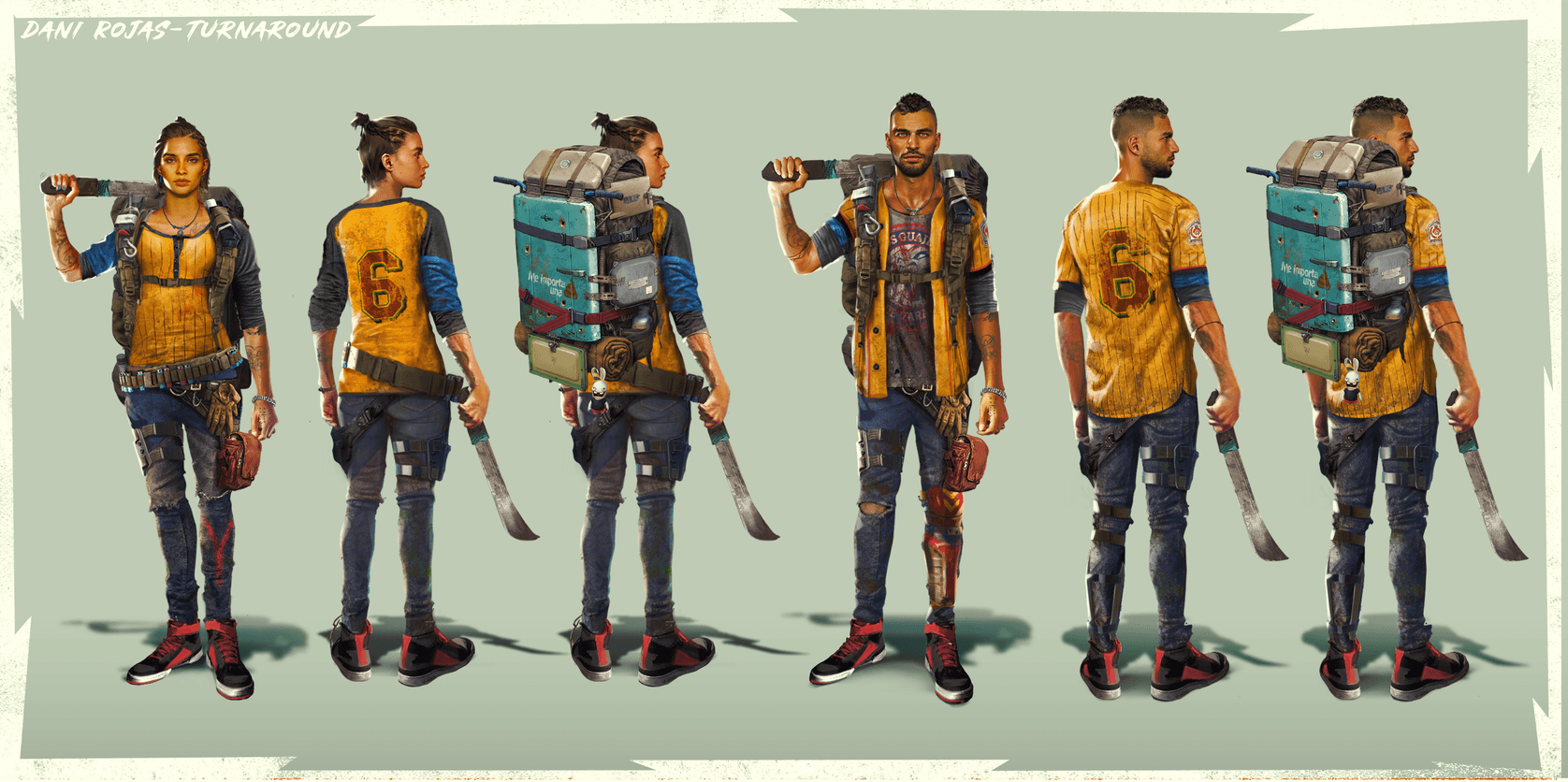
This article also appears on Solid State Now
In Far Cry 6, the latest installment of Ubisoft’s enduring and now iconic franchise, you’re once again thrown into an exotic region in the world where you’ll be going mano a mano with an evil ruler. Here, you’re Dani Rojas, a guerilla who joins the fight to overthrow Anton Castillo, a dictator who rules the fictional country of Yara with an iron fist.
However, this time there’s a concerted effort to ground the action and story and make it a bit more authentic to what we might see in the real world. And a lot of it has to do with the visuals of the game.
We had the chance to have a one-on-one virtual chat with the game’s art director Denny Borges, and we asked him about his approach to creating the look of Yara, Anton Castillo, and the modern guerillas.
Can you first talk about your role in the game’s development? What do you do? Who do you work with?
Denny Borges: Well, I’ve been an art director at Ubisoft Toronto for about six years now. My first art direction role started on Far Cry Primal. Then, I took on the lead art direction role on Far Cry 6.
I’m basically responsible for the visuals of the game. I have an army of associate art directors as well. But it’s really just focused on the high-level art direction and the look of the characters and world.
Far Cry 6 takes players to this Cuba-esque island nation in Yara. Can you talk to me about creating the visuals for the game?
Denny: For Yara, we definitely were inspired by a lot of the Caribbean nations – Cuba being one of them. We wanted to create that feeling of tropical paradise. We loved the idea of an island that’s frozen in time, where you get to see the history; the classic cars; the Caribbean colors. We get to play with beautiful sunrises and sunsets. It really was a perfect opportunity to create our version of the Caribbean islands.
One thing that we have to do is to build a rich and connected world. When we do that, we want to make sure that players are going to a lot of memorable locations. And this is a first for Far Cry, where we have a major capital city, which serves as sort of Anton’s lion’s den in the narrative.

At the same time, we also wanted to have moments of pause. For me, it was really important to make players be in awe when they go to a beach, and they stare at the sunrise or sunset – it’s like they can really feel the heat on the island. Lighting was definitely important for us in getting that tropical look as well as the weather.
When we were looking at adding rain – another first for Far Cry – we wanted to sort of mimic a lot of the changes of the weather of a Caribbean island. You tend to see a short rainfall in the afternoon, which was something that was important to us. Depending on which part of the island you are in, you might see lighter rain versus heavier rain.
How do you think the visuals in the game change the player experience?
Denny: We pushed every limit on the visuals, and we have a lot of memorable characters. For me, it’s capturing the look of our modern guerillas. In terms of the biomes on the island, we even had our team do research and photoscan a lot of the exotic and natural flora that you would find on a Caribbean island. And that level of realism is something that really translates in-game.

In terms of the art, this new Far Cry looks quite different from games in the past, where there’s a strong use of bright and vivid colors and propaganda posters. Did you have any inspirations for crafting the look? What type of research did you do?
Denny: We looked at certain color palettes in Cuba but we also tried to understand how color is used in that country. We wanted to be inspired by that.
For Yara, it’s almost as if the colors of the island are by design. We know that the island lacks resources. And with the lack of resources, a lot of the time, when you want to go paint your house or paint your car, you basically get what’s given to you by the country.
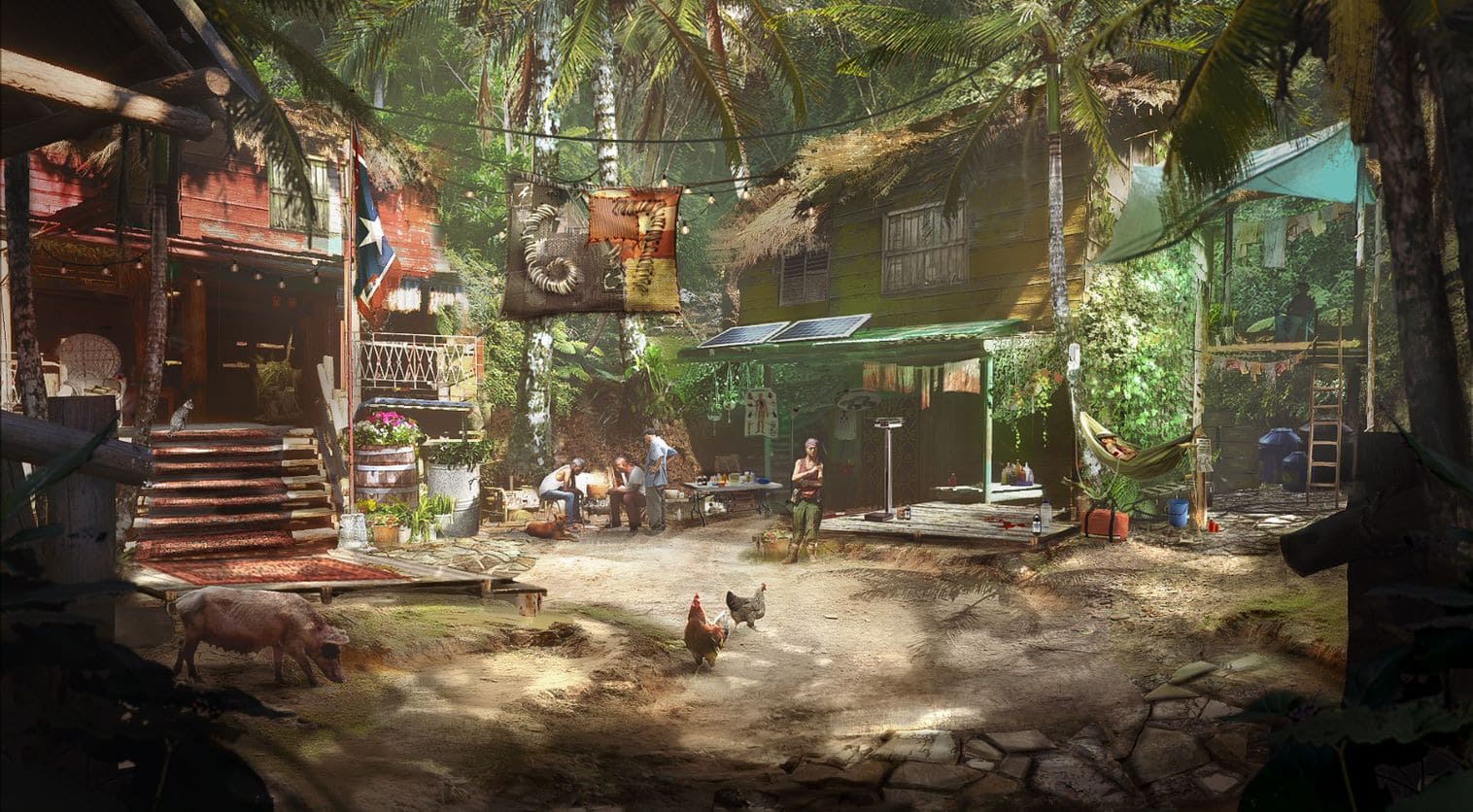
We do have a limited color palette in terms of the cars and locations, but what was really important to us was the idea of expression and personalization. You see this contrast between the modern guerillas and Anton’s army. The idea of expression, personalization, and color is very much more vivid with the guerillas versus that lack of color, the uniformity, and clone-like appearances of Anton’s army.
The Far Cry games have always creatively mixed grounded stories with over-the-top, sandbox action. And I think that’s never been more true than with Far Cry 6. How did you balance these two seemingly opposing ideas when it comes to visuals?
Denny: It was a challenge early on, trying to find that look for our modern guerillas. We came across this term called “resolver” which means to resolve. Because of the lack of resources on the island, it really is about this spirited ingenuity, where the people of Yara would create things based on what they have. I like that approach, and it was something that we found worked with how to create a modern guerilla.
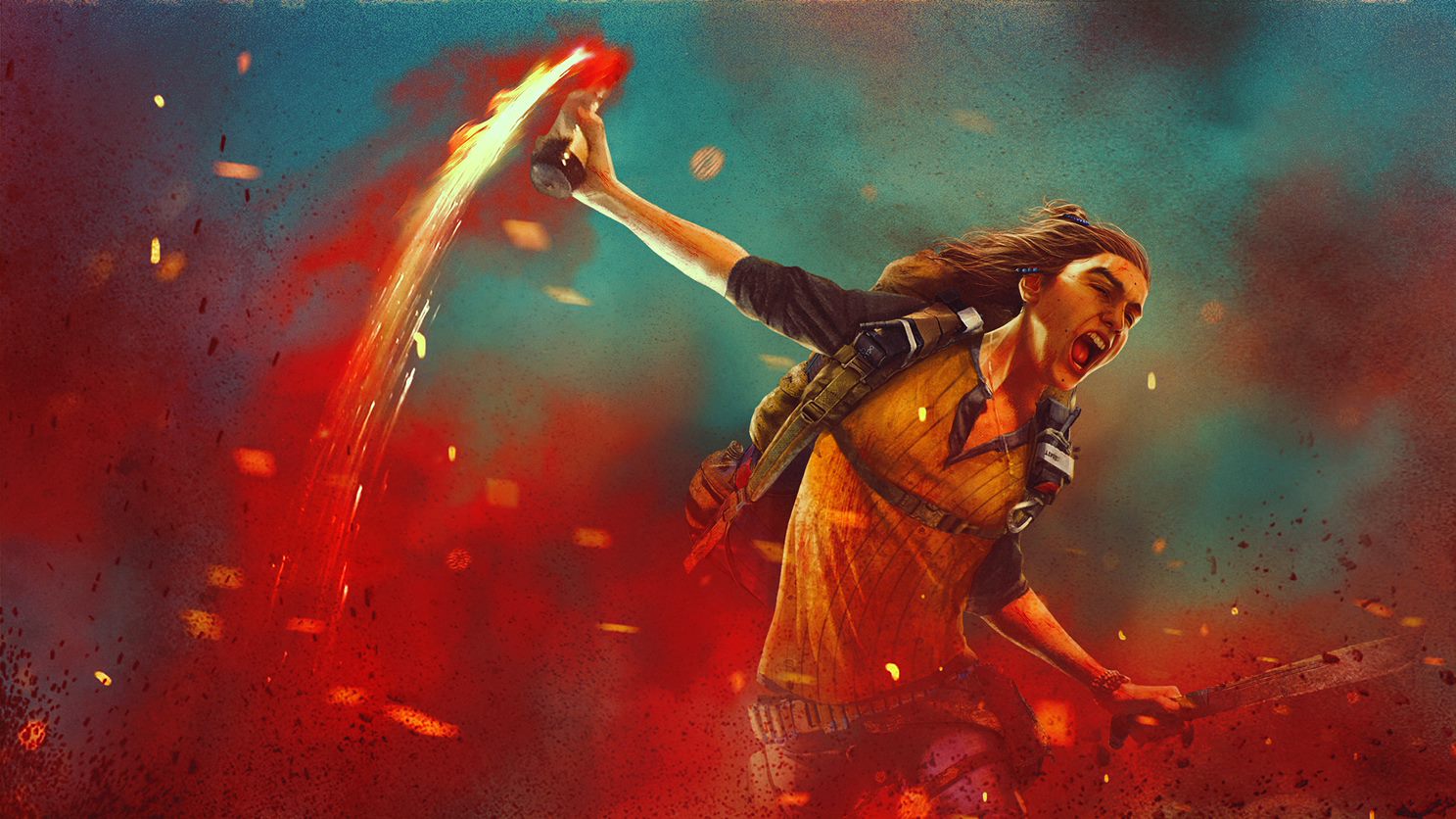
Most people in their minds would have a stereotype appearance of a guerilla when they see images from the past. But we wanted to explore the idea of what a guerilla looks like in this day and age. So we did a lot of research from different revolutions around the world. For me, tying in the idea of “resolver” with personalization and expression really fit well with the modern guerilla. It is this crafted, crazy look, but in the end, “resolver”, for me, is what we see visually as plausible crafting. And plausible crafting means seeing what ordinary things in Yara can be used for something else.
Could you talk to me about Anton’s design as well? I know he’s played by a real actor in Giancarlo Esposito, but you probably had a hand in tweaking how he looks in the game.
Denny: Being a Far Cry fan, everyone looks to the villain. For me, the villain was definitely our priority. We worked a lot with the narrative team to figure out what kind of villain we want and what his entourage is like. It was a long process.
I’m a huge fan of the Far Cry brand and love the focus on the villain. But I also wanted to focus on creating a wide cast of memorable characters. You may have seen some of them in the trailers and previews, but there’s a lot more we haven’t shown yet.
In terms of Anton, we looked at a lot of inspirations for his outfit. We looked at the previous president of Cuba, Batista, who wore some kind of motorcycle leather jacket, which was form-fitting. I really liked that sort of clean-cut look. At one point, we had Anton dressed all in white, but the red comes from the idea of tying the color of the poison he’s using on the typical plants. His branding is the white and red, which he uses on his flags and his outfits.

What’s really great is that Yara’s national flag is red, white, and blue. White and red are Anton’s colors, but the guerillas carry blue. And I like the idea that those three colors are sort of being separated and put against each other.
Anton has a couple of other details that we looked at in terms of what items are on his belt. We really wanted to tie his history to his family. I really liked the idea that he carries his father’s old tobacco pruner on his belt. It’s a little weapon – every Far Cry villain has their own signature weapon. This one is kind of tied more personally to him.
At the same time, he also has one of the national flowers of Yara with him, which is the sunrise mariposa. It’s a little flower that his mother used to wear on her hair when she was a jazz singer.
The items he carries tie to his lineage and legacy, and I really loved adding these little layers to our villains.
What about the protagonist, Dani Rojas? Can you share more about her – or him?
Denny: Dani Rojas is thrown into the revolution when she joins Clara Garcia and her band of modern guerillas. I can’t really speak about the narrative as much, but I really like that Dani’s look comes from someone who is a local of Yara.

The locals love baseball, and they have baseball fields on the island. So having Dani wear a baseball jersey was something that came up early in our development. I like the idea that Dani is someone from the island rather than someone who’s just dropped in. There are personal stakes to Dani. And as she joins the modern guerillas, you see her adopt the idea of “resolver” and build up an arsenal of different gears, gadgets, and vehicles.
It really is about giving the players as many tools at their disposal while fitting it with that “resolver” look of the modern guerilla.
You’ve mentioned a lot about the “resolver” approach to crafting the weapons and tools that these guerillas use. Can you tell me more about it? How did you come up with all these crazy ideas for weapons like the backpack rocket launcher that we see in the trailers?
Denny: Well, the looks of the backpack specifically came from talking to the narrative director about who’s creating them and why. We definitely want to give players a lot of tools at their disposal, as I said earlier.
Narratively, the backpacks are designed by Juan Cortez, who’s kind of the spymaster of the guerillas. They’re inspired by the comic books that he reads. One of them, as you see in the previews, is the backpack that has mortars coming out of the back. We have an EMP backpack as well and a few more that we haven’t shown.
Is it a bit outlandish? I don’t think so. I think it really fits with the “resolver” aspect of the weapons. These are ordinary civilians that want to take up arms, so it’s really about trying to find whatever resource you can to fight a large army.
What would you say was the biggest challenge in working on Far Cry 6?
Denny: There are definitely a few challenges. I think finding the look for our modern guerilla was one of them, for sure.
Building Yara’s capital city of Esperanza was also very important to us. We wanted to make the first Far Cry urban city. And we had to make sure that we were building not just a small city but something large enough where players see various types of districts; places where Anton’s Yarans congregate; and poor versus middle class in rich areas. On top of that, there’s a lot of the propaganda that players will see across the island.
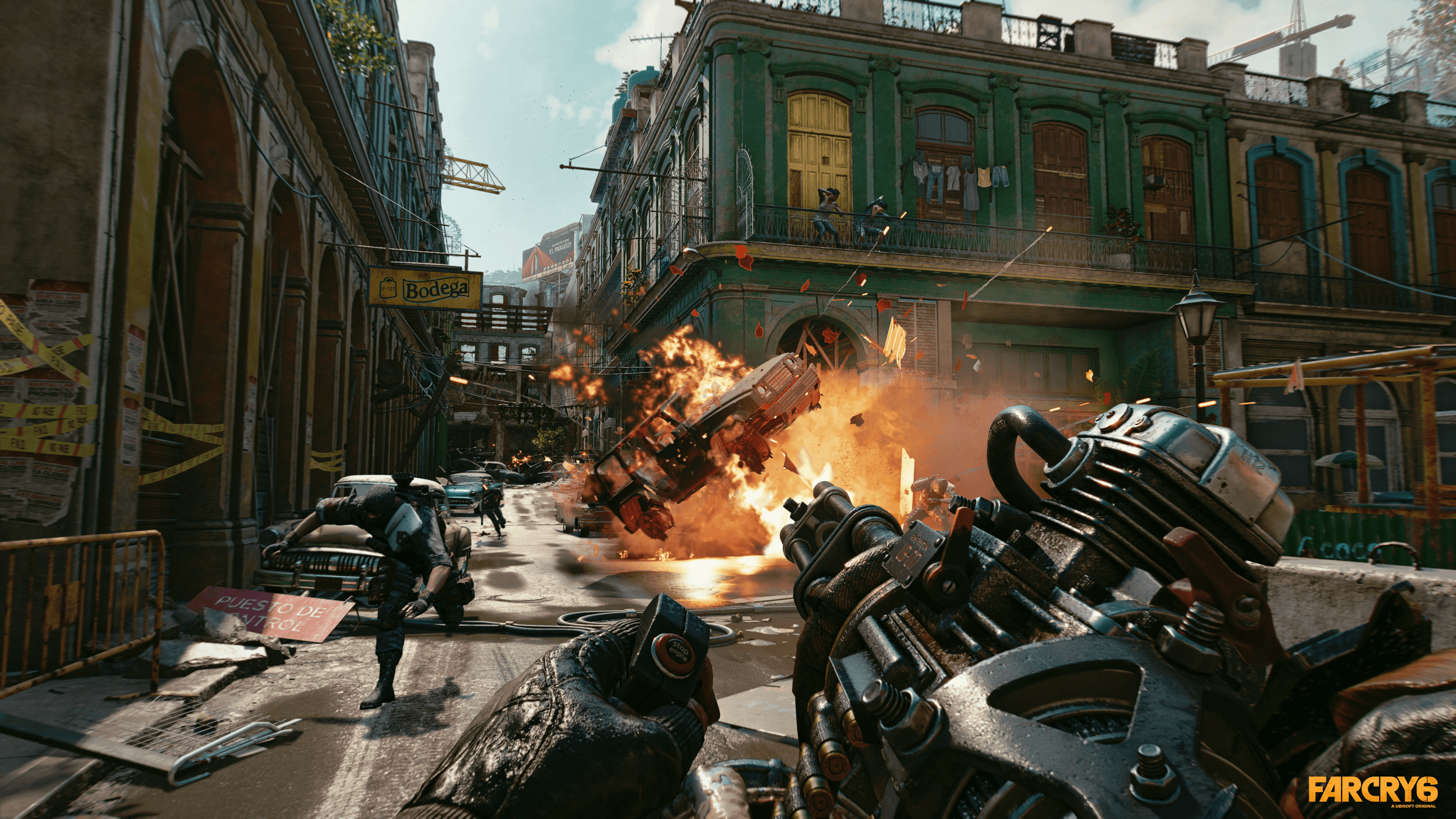
This is the first Far Cry game to come out on this new generation of consoles. Was there anything you did to take advantage of the new hardware?
Denny: I don’t have all the technical details of it, but the game runs at 4K, 60fps on the PS5 and Xbox Series X. We have some ray-tracing but it’s on PC. For me, the best way to play it is across all consoles. I think the game looks great on the PS4, which we optimized for but also on PS5. – Rappler.com
Far Cry 6 launches on PS4, PS5, Xbox One, Xbox Series X|S, and PC on October 7.
Add a comment
How does this make you feel?
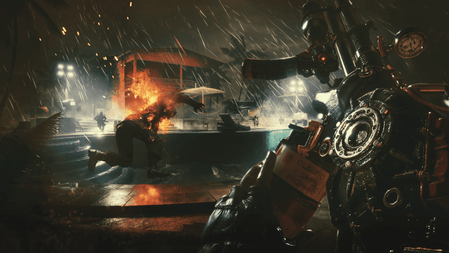
There are no comments yet. Add your comment to start the conversation.